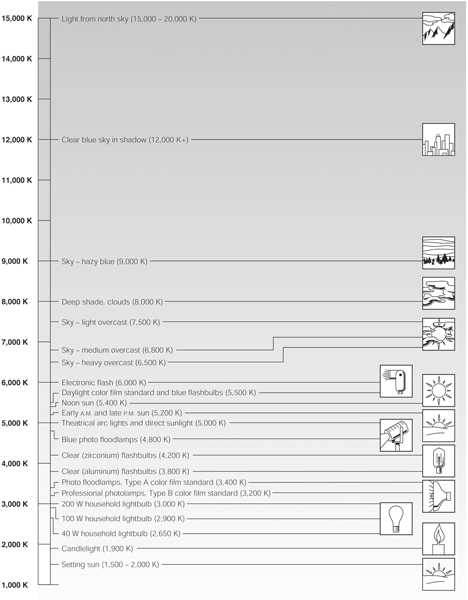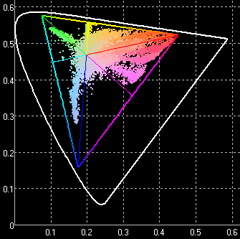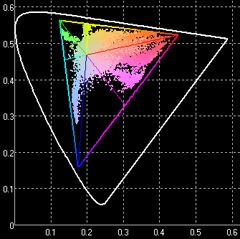Schedule
(subject to change)
http://www.basearts.com/curriculum/Res.Photo.htm
and
basearts resource menu |
http://www.basearts.com/curriculum/resources.html
Syllabus Overview Expectations, Requirements, Objectives, Best Practices.
Assignment:
- Bring Camera to second class meeting with cables (usb/firewire), or card reader.
- Locate and begin reading Camera Manual - Cover to Cover.
- Set Camera to highest resolution / lowest compression.
- TURN
OFF THE FLASH! Until further notice.
- Make 5-10 Digital Camera images between the first and the second class meeting
- Bring these to share on the 2nd class meeting. - (1)
- Begin JOURNAL of questionable functions, settings, usage, portfolio ideas, reading notes etc...
- Email
john@basearts.com with your current email address
- include SRJC Digital Photo and your section number in the subject line.
Local Galleries and Suppliers
Masters of Photography - Good starter site for Analogue Masters
http://www.masters-of-photography.com/
Lomographic
Society
http://www.lomographics.com
Camera Reviews
http://dpreview.com
http://www.keh.com
Lecture:
Digital Technology
Transferring images from camera/media to system.
Begin fundamentals of camera technology/exposure.
Lab:
Establish Home Directories
Work with camera connection / file transfer
Assignment:
Shooting in Low Light without a flash. - (7)
Feel free to experiment, try to find the lowest
level of light possible to render a readable image.
Depending on what you may or may not know regarding ISO, experiment with
this setting in your camera as well.
Reading:
Local Galleries and Suppliers
Moholy-Nagy - From Pigment to Light - 1936
Artists:
Lazlo
Moholy-Nagy
Man Ray
David Hockney
Olivia Parker
http://oliviaparker.com/newindex.php
Bruce Conner
David Hockney
Lecture:
-
Camera Operation
Exposure basics
- Photoshop Introduction
File Browser - Bridge
File Types, Format
Lab
First File Transfers
Assignment:
Bracketing Exposures
3 Subjects - 3-5 exposures for each with alternate exposure. - (3)
1st exposure according to meter reading.
2nd + .5 half step greater aperture/shutter selection or more exposure
(over)
3rd + 1 whole step (full stop) greater aperture/shutter selection (over)
4th .5 half step smaller aperture/shutter selection or less exposure (under)
5th - 1 whole step smaller aperture/shutter selection or less exposure
(under)
------------------------
Experiment with White Balance Bracketing.

Reading:
Digital Camera Review - Technical Glossary
http://www.dpreview.com/learn/?/Glossary/
http://www.dpreview.com/learn/?/Glossary/Camera_System/
Artists:
Paul Strand
Eugene Atget
Eadweard Muybridge
-----------
Sites:
Lecture:
Camera Operation
- Exposure basics
- Zone
System Introduction: (Digital Application) Practical
Fig 1
Fig 2
Zone System | Wikipedia Entry:
http://en.wikipedia.org/wiki/Zone_System
Lab:
We will break at 6:30 to make the Chuck Close Lecture by Kenneth Baker at the
Sonoma County Museum
425 7th Street
(
directly across from the Macy's Parking lot of the 4th Street Mall.)
Please try and attend.
Artists:
Edward Weston
Minor White
Ansel Adams
FRED ARCHER
Robert Adams
Uta Barth
http://www.sieshoeke.com/artists/uta-barth
Sites:
The photographs in Intimate Nature: Ansel Adams and the Close View represent an under recognized and rarely examined aspect of Ansel Adams's half-century-long career: his study of the intimate details of nature through the close view of his camera.
http://www.creativephotography.org/education/educatorsGuides/anselAdams/
Other Guides:
http://www.creativephotography.org/education/educatorsGuides/
Best Practices - Beginning Camera Setup
------------
Camera Configuration
- Highest Resolution
- Lowest Compression
- No Flash
- Shooting Modes - (*P), Av, Tv, M
- ISO - lowest required (*Auto, 50, 80, 100, 200, 400), 800, 1600, 3200
- White Balance - Auto
Bracket exposures - .5-.7 over and under
-------------
Testing and Experimentation with :
- Half Step Shutter Lock
Auto Exposure
Auto Focus
- Auto Bracketing
- White Balance Bracketing
- Metering/Exposure and Focus Modes - Multizone/Pattern, Center-weighted, Spot
- Exposure Compensation
-------------
Best Practices Camera
- Format media card after every major upload
(erase all, delete all, format)
-------------
Work Flow
Adobe Bridge / Camera Raw - preview and editing
Week 2.1
Lecture:
Best Practices - Beginning Camera Setup
Beginning Vocabulary
Exposure Continues ...
Lab:
Wikipedia Entry:
http://en.wikipedia.org/wiki/Zone_System
Depth of Field Calculator
http://www.dofmaster.com/dofjs.html
---
Assignment:
---
Camera / Scanner
Scanning Procedures - Flat Art
Objects for Scanning - 3 Dimensional Objects as well as prints or flat
art that you may want to digitize. - (2)
Review Historical Photograms/Montage works:
Photograms
and Montage Samples
Niko Robinson - Student Scanner work
more scanner work - various
Discussion : Moholy-Nagy - From Pigment to Light - 1936
Readings:
Ansel Adams - .pdf - 344KB - 3 pages
Edward Weston - .pdf - 360KB - 3 pages
(first left hand spread of each essay is last page of that essay)
Artists:
Henri
Cartier-Bresson
http://www.magnumphotos.com/Archive/C.aspx?VP=XSpecific_MAG.PhotographerDetail_VPage&l1=0&pid=2K7O3R14T1LX&nm=Henri%20Cartier%20%2D%20Bresson
Hiroshi Sugimoto
http://www.sugimotohiroshi.com/portfolio.html
John Divola
http://www.divola.com/
Sites:
Depth of Field Calculator
http://www.dofmaster.com/dofjs.html
Zone System | Wikipedia Entry:
http://en.wikipedia.org/wiki/Zone_System
Lecture:
Camera:
Best Practices
Photoshop
-
File Browser - Adobe Bridge Intro
- Contact Sheet
Assignment:
- Equivalents: Depth of Field
3-5 Images which illustrate the side effects of aperture selections. -(4)
Aperture:
Fig. 1
Fig. 2
Lab:
Reading:
Henri Cartier-Bresson - .PDF - 234KB
Artists:
Lauren Greenfield
http://www.creativephotography.org/education/educatorsGuides/girlculturefacultyguide/
Henry Wessel
http://www.renabranstengallery.com/wessel.html
Stephen Shore
http://www.masters-of-fine-art-photography.com/02/artphotogallery/photographers/stephen_shore_13.html
Todd Hido
Larry Sultan
Sites:
Lecture:
Photoshop:
- Adjustment Layers
- Levels Adjustment Layers
- Histogram
- Size / Resize / Resolution
PS Best Practice #1 - Duplicate the pixel
based background layer as first step on opening a .jpeg.
PS Best Practice #2 - All adjustments to adjustment layers - no
pixel damage.
Assignment:
-
Equivalents: Motion / Blur
3-5 Images which illustrate the side effects of shutter speed / time
value selections. - (5)
Shutter / Time Values:
Fig 1
---
Review :
Bracketing
Equivalents (Shutter and Aperture side effects)
1st Critique- 10-15 images of your own work - looking toward portfolio subjects. If you haven't made any decisions it could be just images you have made since the beginning of the semester that you believe were good.
---
Assignment:
Contact Sheets of Brackets/Equivalents
Create a minimum of 3 contact sheets documenting bracketing exposure experiments. - (6)
Artists:
John Baldessari
Sophie
Calle
Nick Waplington
---
Michael Light
http://www.michaellight.net/
Lecture:
Photoshop:
PS Best Practice #1 - Duplicate the pixel based background layer as
first step on opening a .jpeg.
- Adjustment Layers
- Levels Adjustment Layers
Assignment:
Critiques - 5 pnts.
5 Images - should represent beginnings of portfolio subjects either content
or technique. Assignment:
William Klein
Lorna Simpson
Richard Prince
David Hockney
William Carlos Williams
Photoshop:
PS Best Practice #1 - Duplicate the pixel based background layer as
first step on opening a .jpeg.
PS Best Practice #2 - All adjustments to adjustment layers - no
pixel damage.
- Histogram
- Size / Resize / Resolution
- Curves - Adjustment Layers
- Channel Mixer- Adjustment Layers
Artists:
Diane Arbus
Lorna Simpson
Bernd and Hilla Becher
Gregory Crewdson
Reading:
Robert Adams - Truth
Robert Adams - Beauty
Sites:
- Working with layers as masks
- Sharpening
Unsharp Mask
- History Brush
- Compositing
- Extract
- Selections - Paths (Pen)
- Blending Options
Subject explorations / Framing exercise. - (8)
Shoot a minimum of 20 images of a single subject from every angle and a variety of compositional arrangements.
explore position/ balance/ background/ etc...
Lecture:
- Random Photoshop tools
- ruler
- skew/perspective Tranformations for barrel or pincushion distortion (not parallax) see ref:
http://en.wikipedia.org/wiki/Image_distortion
- Text - Typography
Text tools
Vector graphics
Roxio Toast - CD and DVD Burning
Photoshop:
- Sharpening
- LAB
Color Mode/Luminance Sharpening
- Photoshop:
- Size/Resize/Resolution (review)
- File Preparation
- Color Management
- Color Modes
Printing
Process to Print Handout
Processing
a Digital Image.pdf (for print)
Printer Profile File Names: profilenames
Printing Demonstration - Epson R1800 / 1280 Printer
:


-
Papers
Surface/Finish
Texture
Color
Weight
Assignment:
Printing
5 prints - 5 pnts. - 8x10
minimum - (9)
Lab:
Printing continues through to the end...
Additional
Printing Resources:
http://www.basearts.com/curriculum/PDF/ - see contents for various PDFs
LAB:
Critique ongoing- Current progress on portfolios - (5 pnts)
Artists:
Harold Edgerton
Richard Avedon
Irving Penn
Device/Paper Profiles - additional resources http://www.basearts.com/Res.Printing.htm
Device/Paper
Profiles - additional resources
http://www.epson.com/profiles
http://www.moabpaper.com/profiles
http://www.ilfordpaper.com/profiles
http://www.inkpresspaper.com/ profiles
http://www.redrivercatalog.com/profiles/index.htm
-----------------
Print Permanence
- An Epson White Paper -
http://www.epson.co.jp/e/technology/print_permanence_basics.htm
Color
Field Guide - how to install and apply
Epson's ICC
Profile Guide
Red River Paper
-How to Install and apply profiles.Epson(PC)
Red River Color Profiles
-How to Epson(MAC)
Digital Art Supplies (San Diego based, print supply )
http://www.digitalartsupplies.com
PS Print (LA based commercial printer)
http://www.psprint.com/
Preparing files for print - Pagemaker, Illustrator
http://www.psprint.com/helpcenter/preparingyourfiles/digitalcheck_pm.asp
---------------local printers santa rosa
Northbay Photo Supply (Santa Rosa, based photo supply)
http://www.photosupply.com
location map
http://www.photosupply.com/aboutusindex.htm
Skylark Images
http://www.skylarkimages.com/
The Lab
http://www.thelabsantarosa.com
Lenny Eiger
http://www.eigerphoto.com/index_ep.php
Week 4.3 & 4.4
Printing
Process to Print Handout
Processing
a Digital Image.pdf (for print)
Printer Profile File Names: profilenames
Critique - Current progress on portfolios - (5 pnts)
------------
Assignment:
3-5 images of light - (10)
- Pre-Visualization
- sensitivity toward the lighting conditions(less focus on subject)
Lab
Camera RAW
HDR - High Dynamic Range Imaging
Resource Links for Camera Raw and HDR
Reading:
Resource Links for Camera Raw and HDR
About Camera Raw
A camera raw file contains unprocessed, uncompressed grayscale picture data from a digital camera’s image sensor, along with information about how the image was captured (metadata). Photoshop Camera Raw software interprets the camera raw file, using information about the camera and the image’s metadata to construct and process a color image.
Think of a camera raw file as your photo negative. You can reprocess the file at any time, achieving the results that you want by making adjustments for white balance, tonal range, contrast, color saturation, and sharpening. When you adjust a camera raw image, the original camera raw data is preserved. Adjustments are stored as metadata in an accompanying sidecar file, in a database, or in the file itself (in the case of DNG format).
When you shoot JPEG files with your camera, the camera automatically processes the JPEG to enhance and compress the image. You generally have little control over how this processing occurs. Shooting camera raw images with your camera gives you greater control than shooting JPEG images, because camera raw does not lock you into processing done by your camera. You can still edit JPEG and TIFF images in Camera Raw, but you will be editing pixels that were already processed by the camera. Camera raw files always contain the original, unprocessed pixels from the camera.
To shoot camera raw images, you need to set your camera to save files in its own camera raw file format.
Digital cameras capture and store camera raw data with a linear tone response curve (gamma 1.0). Both film and the human eye have a nonlinear, logarithmic response to light (gamma greater than 2). An unprocessed camera raw image viewed as a grayscale image would seem very dark, because what appears twice as bright to the photosensor and computer seems less than twice as bright to the human eye.
About high dynamic range images
The dynamic range (ratio between dark and bright regions) in the visible world far exceeds the range of human vision and of images that are displayed on a monitor or printed. But whereas human eyes can adapt to very different brightness levels, most cameras and computer monitors can capture and reproduce only a fixed dynamic range. Photographers, motion picture artists, and others working with digital images must be selective about what’s important in a scene because they are working with a limited dynamic range.
High dynamic range (HDR) images open up a world of possibilities because they can represent the entire dynamic range of the visible world. Because all the luminance values in a real-world scene are represented proportionately and stored in an HDR image, adjusting the exposure of an HDR image is like adjusting the exposure when photographing a scene in the real world. This capability lets you create blurs and other real-world lighting effects that look realistic. Currently, HDR images are used mostly in motion pictures, special effects, 3D work, and some high-end photography.
PhotoMatix
http://hdrsoft.com/
Handouts
http://www.basearts.com/curriculum/PDF/CameraRaw/
ProPhoto RGB
romm_rgb.pdf
http://www.basearts.com/curriculum/HDR/
Field
Trip :
Graton, CA.
Graton - meeting
in central Graton -
map to Graton: http://www.mapquest.com/maps/map.adp?searchtype=address&country=US&addtohistory=&searchtab=home&formtype=address&popflag=0&latitude=&longitude=&name=&phone=&level=&cat=&address=&city=Graton+&state=CA&zipcode=
http://www.santarosa.edu/for_students/student_affairs/forms.shtml
Lecture
Lecture:
- Lens Selection
Lens Selection:
Link to external sites of interest regarding lens selection
DPReview Lens Reviews
http://www.dpreview.com/lensreviews/
DP Review Lens Widget:
http://www.dpreview.com/lensreviews/
Angle of View:
Fig 1
- Lighting
- Utilizing Ambient Light
- Flash
- Composition
-tone
-balance
-line
-framing
Automation / Scripting
Critique - 5-10 Progress toward final subjects
Review images of light.
Printing continues ...
Reading:
Susan Sontag - Plato's Cave
Artists:
Diane Arbus
Jeff Wall
Richard Barnes
---
Matt Williams Collection of composition links:
Rule of Thirds
http://digital-photography-school.com/blog/rule-of-thirds/
More on the Rules of Photography
http://macteens.com/magazine/features/fullstory/the_rules_of_photography/
Holding your Camera at an Angle
http://digital-photography-school.com/blog/hold-your-camera-on-an-angle/
Rules for Landscape Photography
http://digital-photography-school.com/blog/4-rules-of-composition-for-landscape-photography/
Diagonal Lines
http://digital-photography-school.com/blog/using-diagonal-lines-in-photography/
Converging Lines
http://digital-photography-school.com/blog/converging-lines/
Foreground
http://digital-photography-school.com/blog/pay-attention-to-foregrounds/
Framing
http://digital-photography-school.com/blog/framing-your-shots-photography-composition-technique/
http://digital-photography-school.com/blog/5-elements-of-composition-in-photography/
Assorted:
Rule of Thirds
http://en.wikipedia.org/wiki/Rule_of_thirds
http://en.wikipedia.org/wiki/Image:Rule_of_thirds_1845_George_Field_Chromatics.png
Golden Mean
http://en.wikipedia.org/wiki/Golden_ratio
http://www.cambridgeincolour.com/tutorials.htm
http://www.cambridgeincolour.com/tutorials/camera-lenses.htm
http://www.cambridgeincolour.com/tutorials/hyperfocal-distance.htm
Lecture:
Internet Presence / Websites
- Batch and Automation
- Image Ready
- Optimization
Legal / Copyright Issues
Protecting your images
Respecting the work of others
Legal and Photorelease - Handout
Photographers Rights - pdfs
Photography - Model Release Examples
graton field trip ?
Reading:
Photo Sharing
http://www.webshots.com/
http://www.dpchallenge.com
http://www.flickr.com/
http://www.slide.com
http://www.kodakgallery.com/
http://www.snapfish.com/
http://www.shutterbook.com/home/
http://www.deviantart.com/
http://www.zoto.com/
www.smugmug.com
Commercial Photographers - Online presence (sampling)
http://www.svenwiederholt.com/
http://www.peterkoval.com/
http://www.nadavkander.com
http://www.jockmcdonald.com/
http://www.milesaldridge.com/
http://www.marcleclef.com/
Artists :
Mark America
Jodi.org
Lynn Hershman Leeson
http://www.lynnhershman.com
George LeGrady
http://www.georgelegrady.com
John Maeda
http://www.maedastudio.com/
http://dbn.media.mit.edu/
http://www.maedastudio.com/indexold.html
http://acg.media.mit.edu/people/maeda/
Ted Nelson
http://www.iath.virginia.edu/elab/hfl0155.html
http://xanadu.com/
http://ted.hyperland.com/
Lev Manovich
http://www.manovich.net/bio_00.htm
http://www.manovich.net/
http://en.wikipedia.org/wiki/Lev_Manovich
Victoria Vesna
http://www.bodiesinc.ucla.edu/
Timothy Druckrey
http://users.rcn.com/druckrey/
http://users.rcn.com/druckrey/texts.html
Additional Readings:
Orphan Works
An orphan work is a copyrighted work where it is difficult or impossible to contact the copyright holder. This situation can arise for many reasons. The author could have never been publicly known because the work was published anonymously or the work may have never been traditionally published at all. The identity of the author could have been once known but the information lost over time. Even if the author is known, it may not be possible to determine who inherited the copyright and presently owns it. Nearly any work where a reasonable effort to locate the current copyright owner fails can be considered orphaned. However the designation is often used loosely and in some jurisdictions there is no legal definition at all.
http://en.wikipedia.org/wiki/Orphan_works
http://www.copyright.gov/orphan/
-----------------
Lab
Text - Typography
- Text tools
- Vector graphics
Margaret Bourke-White
Tina Modotti
Immogen Cunningham
Nan Goldin
Sally Mann
Sherry Levine
Judy Dater
Annie Liebovitz
Graciela Iturbide
Presentations of selections from individual portfolios 10-20 images. = 10 pnts
Final Exam is here --> TEST
Lomo Effect for Photoshop
ive tried a few websites but this one seemed to give the closest effects to a real lomo camera.
http://photoshoptutorials.ws/photoshop-tutorials/photo-effects/lomography.html
from Anna Evey
Walter Bejamin, "The Work of Art in the Age of Mechanical Reproduction", 1936 - Excerpt translanted by Harry Zohn
